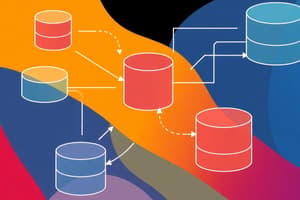Podcast
Questions and Answers
What is the maximum number of courses a Professor can deliver?
What is the maximum number of courses a Professor can deliver?
- Two
- Multiple
- One (correct)
- Three
Which attribute can be associated with the 'Student' entity based on the information?
Which attribute can be associated with the 'Student' entity based on the information?
- Professor Name
- Course Name
- Delivery Method
- Student ID (correct)
Which of the following is a recommended practice for developing effective ER diagrams?
Which of the following is a recommended practice for developing effective ER diagrams?
- Duplicate entities to enhance clarity
- Use a single color for the entire diagram
- Connect relationships to each other
- Label all entities and relationships (correct)
What is the relationship between a student and a course?
What is the relationship between a student and a course?
What is a primary method for identifying attributes in your entities?
What is a primary method for identifying attributes in your entities?
What aspect does a physical data model primarily address?
What aspect does a physical data model primarily address?
Which characteristic is specific to the physical data model?
Which characteristic is specific to the physical data model?
What is the primary goal of data modeling?
What is the primary goal of data modeling?
What is one advantage of employing a data model?
What is one advantage of employing a data model?
What is a primary disadvantage of the data modeling process?
What is a primary disadvantage of the data modeling process?
Which of the following is NOT a basic tenet of data modeling?
Which of the following is NOT a basic tenet of data modeling?
What distinguishes the conceptual model from the logical model?
What distinguishes the conceptual model from the logical model?
Which feature distinguishes the ER model's usability?
Which feature distinguishes the ER model's usability?
At which level of data modeling are primary and foreign keys defined?
At which level of data modeling are primary and foreign keys defined?
What is a key disadvantage of the Entity-Relation model?
What is a key disadvantage of the Entity-Relation model?
How does the ER model facilitate database design?
How does the ER model facilitate database design?
What is a characteristic of the logical model of data modeling?
What is a characteristic of the logical model of data modeling?
Which term represents the connection between two entities in a conceptual model?
Which term represents the connection between two entities in a conceptual model?
What does the physical data model help to visualize?
What does the physical data model help to visualize?
In what way is the physical model different from the logical model?
In what way is the physical model different from the logical model?
What is the focus of the conceptual model in data modeling?
What is the focus of the conceptual model in data modeling?
What is the primary purpose of an ER diagram?
What is the primary purpose of an ER diagram?
Which component of an ERD uniquely identifies a record in a database table?
Which component of an ERD uniquely identifies a record in a database table?
How are relationships within an ERD represented?
How are relationships within an ERD represented?
Which of the following is true about a Foreign Key in an ERD?
Which of the following is true about a Foreign Key in an ERD?
What does the term 'cardinality' refer to in the context of ER diagrams?
What does the term 'cardinality' refer to in the context of ER diagrams?
Which of the following accurately describes an Entity in an ERD?
Which of the following accurately describes an Entity in an ERD?
What role do ER diagrams play in database design?
What role do ER diagrams play in database design?
In a university ERD context, how is a student related to courses?
In a university ERD context, how is a student related to courses?
Flashcards are hidden until you start studying
Study Notes
Data Modeling
- Process of creating visual representations of information systems to illustrate relationships between data points and structures.
- Goals include accurate representation of data objects, aiding in database design at conceptual, physical, and logical levels.
- Data models define relational tables, primary and foreign keys, stored procedures, and identify missing or redundant data.
- Facilitates cost-effective upgrades and maintenance of IT infrastructure.
Levels of Data Modeling
- Conceptual: Establishes entities, attributes, and their relationships; example entities include Customer and Product.
- Logical: Adds more detail, defines structure and relationships without specifying keys; normalization typically applied to 3NF.
- Physical: Describes specific database implementations, including schema generation, keys, constraints, and DBMS features.
Characteristics of Data Models
- Conceptual Model: Focused on user perception, independent of hardware/software specifications, covers business concepts organization-wide.
- Logical Model: Integrates project-specific data needs; specifies data types and lengths; structured generically.
- Physical Model: Tailored for specific DBMS versions; outlines data needs for individual projects, including precise definitions for keys and data types.
Advantages of Data Modeling
- Accurately represents data objects and aids in physical database construction.
- Facilitates communication within and across organizations regarding data sources.
- Defines relationships between tables, enhancing understanding of data structure.
Disadvantages of Data Modeling
- Requires comprehension of physical data characteristics to develop effectively.
- Complex application management necessitates thorough knowledge.
- Even minor changes can require extensive modifications.
Entity-Relationship (ER) Model
- Graphically represents data, simplifying communication between developers and stakeholders.
- ER diagrams assist in database design and serve as a blueprint for implementation.
Importance of ER Diagrams (ERD)
- Clarifies terms related to entity relationships and data structure.
- Provides a visual representation of table connections and fields.
- Translatable into relational tables for quick database construction.
- Enhances understanding of database content, supporting designers in planning.
Components of ERD
- Entity: A definable thing within a system (e.g., Student, Invoice).
- Attribute: Characteristics of an entity; also referred to as columns.
- Primary Key (PK): Uniquely identifies a record within a database table.
- Foreign Key (FK): References a primary key, highlighting relationships between entities.
- Relationship: Illustrates the association between two entities.
- Cardinality: Defines the occurrences of one entity relative to another, with categories: one-to-one, one-to-many, and many-to-many.
Steps to Create an ERD
- Identify entities: For example, Student, Course, and Professor in an educational context.
- Identify relationships, such as a student being assigned to courses or a professor delivering a course.
- Determine cardinality implications (e.g., one student can take multiple courses, one professor delivers one course).
- Gather attributes through files, forms, interviews, and reports.
Best Practices for Developing ER Diagrams
- Eliminate redundant entities and ensure all entities/relationships are labeled.
- Support comprehensive data storage needs by ensuring all relationships are accurately defined.
- Ensure each entity appears only once to maintain clarity in the diagram.
- Use colors to highlight significant portions, improving visual accessibility.
Studying That Suits You
Use AI to generate personalized quizzes and flashcards to suit your learning preferences.





